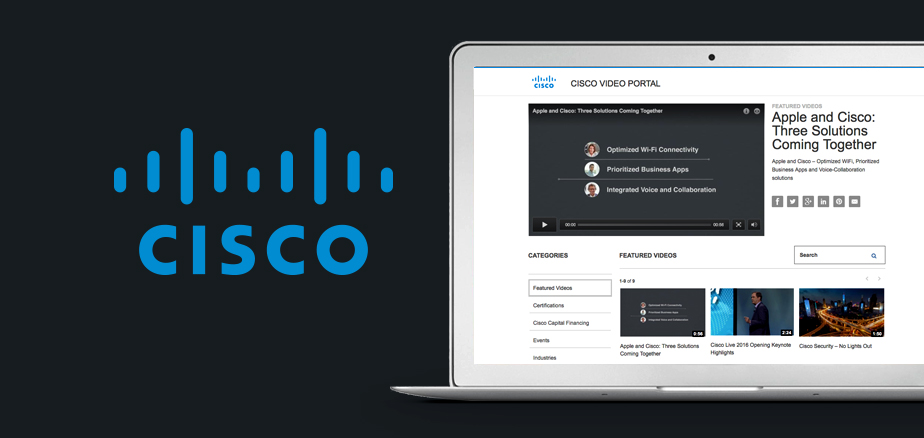How Cisco is Leading Digital Marketing with Video
Brightcove News

Anyone can find basic solutions to run videos on their web site, but few can operate, innovate and unlock its value at scale. At Cisco, users across the globe in departments as diverse as Marketing, Corporate Affairs, Investor Relations, and Support, are creating, uploading and measuring video content. Cisco hosts 200 new uploads each month across 753 unique publishers located around the world.
And the videos are impactful: in FY2016, we had 58 million impressions, 4.9 million views, and over 258,000 hours of engagement.
Here is how we got there.
First, our goal is to enable – not control. Cisco is a globally distributed corporation and we recognize that it is impossible to centralize control of video. In fact, trying to control the creation and distribution of video would slow its adoption. We make the process as transparent and easy as possible, and that means integrating with the right tools. We also work with internal teams to establish rules for uploading videos to ensure compliance with brand guidelines and governance.
Six Critical Tools To Optimize the Adoption and Success of Video
These 6 tools have lowered the barrier to entry and optimized Cisco’s video initiatives.
Web Analytics –Integrating your video platform with your organization’s web analytics platform is the most critical tool for measuring ROI. You can track the viewer visits to the website; what they clicked on; where they went next in the website, what they did during their visit.
This data helps structure the engagement based on how much of the video they viewed. It also helps producers decide where and how to focus their video production investments for new launches and campaigns.
Marketing Automation Platforms – The integration of your video and marketing automation platforms provides greater insight into a prospect’s level of interest. It identifies who specifically clicked on a video, how they accessed the video, how many times they viewed it and how much of it they watched. For direct marketing campaigns, you can identify viewers by name, providing account managers with a more complete picture of the customer or prospect’s engagement.
Big Data and Data Visualization systems – These enable you to combine video data sources, web logs, offer management systems, and CRM into a visually intuitive performance dashboard. Video publishers can visualize the omni-channel performance.
Search/Content Libraries – Leverage video platform APIs to index video assets and make it easy to search for video content. This also helps keep the asset library organized so publishers do not reproduce content or duplicate an upload. This goes for Corporate and Partner marketing organizations.
Web CMS and Communities – Creating video components and listing standardized embed codes for various usage is key to simplify web publishing operations and adoption.
Video Platform Technology partners –We integrated our video platform with innovative technology partners to improve global usability and reduce costs. Some of the key capabilities that are making an impact at Cisco are:
- Caption authoring has saved our globalization team 50% year over year. We no longer have to localize files in multiple languages and host multiple assets.
- Interactive video capabilities enable us to deliver relevant offers to viewers and increase response and revenue. This is the foundation for ROI for demand generation programs offering video.
- Global self-publishing system enables anyone at the company to effortlessly upload and categorize their video assets to the online video system and YouTube, reducing the publishing time from 5 days to 1 hour.
Engagement, Response, Revenue - the Only Meaningful KPIs
Metrics influence what you need to produce, what you’re going to deliver and what you are measured against within your company. The number of video views is the most frequently discussed metric, but video views only measure how successfully you promoted the video. True ROI comes when viewers reveal themselves, become leads, and ultimately result in conversion, bookings, and revenue.
Our key metrics at Cisco:
The % of video viewed. That is a measure of the content engagement itself. Is the video content compelling enough for people to keep watching? Overall, our video viewers consume 10% of the total messaging opportunity across all assets.
Click through rate from the call to action. Is the CTA engaging enough? How many viewers who clicked through were registered? How many identified themselves? How many were new contacts? These metrics enable publishers to relate the cost of video production to the cost of getting a new contact and ultimately to the amount of revenue that came as a result of the video. Current Call-to-Action click-through rate averages around 7%
Bottom line is to be smart about how you create and measure video. The goal is to drive business value.


